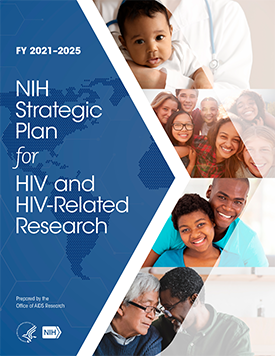Fiscal Year 2021-2025 NIH Strategic Plan for HIV and HIV-Related Research
Topics

Cross-posted from National Institutes of Health Office of AIDS Research
In Fiscal Year (FY) 2020, the NIH Office of AIDS Research (OAR) released two key documents to guide the NIH HIV/AIDS research program for years to come: (1) The FY 2021–2025 NIH Strategic Plan for HIV and HIV-Related Research (the Plan), and (2) the FY 2021–2025 Notice (NOT-OD-20-018), which present NIH HIV/AIDS Research Priorities and Guidelines for Determining HIV/AIDS Funding.
The FY 2021–2025 Plan serves as the guiding framework for OAR to allocate funds to the NIH Institutes, Centers, and Offices that advance the NIH-wide HIV research agenda and ensure investment of resources in the highest priority areas. For example, one emergent activity utilizing the Plan is NIH-wide support for the Ending the HIV Epidemic: A Plan for America Initiative launched in 2019. In addition, Notice - NOT-OD-20-018 was announced as part of the process to incorporate stakeholder insights. The Notice informs the scientific community about the NIH HIV/AIDS research priorities and guidelines for the allocation of HIV funding.
The Plan outlines a comprehensive research agenda that extends across the lifespan and is inclusive of all people with or at risk for HIV and provides a framework for focusing investments and partnerships, in novel ways, to catalyze innovation and scientific discovery. Based on the current state of the HIV pandemic and the global and national objectives, the Plan focuses on four strategic goals that emanate from the scientific priorities for FY 2021–2025:
- Advance rigorous and innovative research to end the HIV pandemic and improve the health of people with, at risk for, or affected by HIV across the lifespan.
- Ensure that the NIH HIV research portfolio remains flexible and responsive to emerging scientific opportunities and discoveries.
- Promote dissemination and implementation of research discoveries for public health impact across agencies, departments, and stakeholders within the U.S. Government and globally.
- Build human resource and infrastructure capacity to enhance sustainability of HIV research discovery and the implementation of findings by a diverse and multidisciplinary workforce.
Additionally, the multiyear Plan harmonizes the cycle of priority-setting for the NIH HIV research agenda with the overarching NIH-wide Strategic Plan and other U.S. Government plans for addressing HIV, including the National HIV/AIDS Strategy for the United States, Ending the HIV Epidemic: A Plan for America, and the President’s Emergency Plan for AIDS Relief (PEPFAR), as well as the international 90-90-90Exit Disclaimer and 95-95-95Exit Disclaimer initiatives launched by the Joint United Nations Programme on HIV/AIDSExit Disclaimer (UNAIDS).
Globally, and in the United States, new HIV infections persist at rates that are incompatible with ending the HIV pandemic. NIH will use the Plan to continue leading the way with cutting edge research to address the ongoing challenges and move us closer to ending the HIV epidemic.
I encourage you to visit the OAR website and our NIH Strategic Plan for HIV and HIV-Related Research page to learn more.